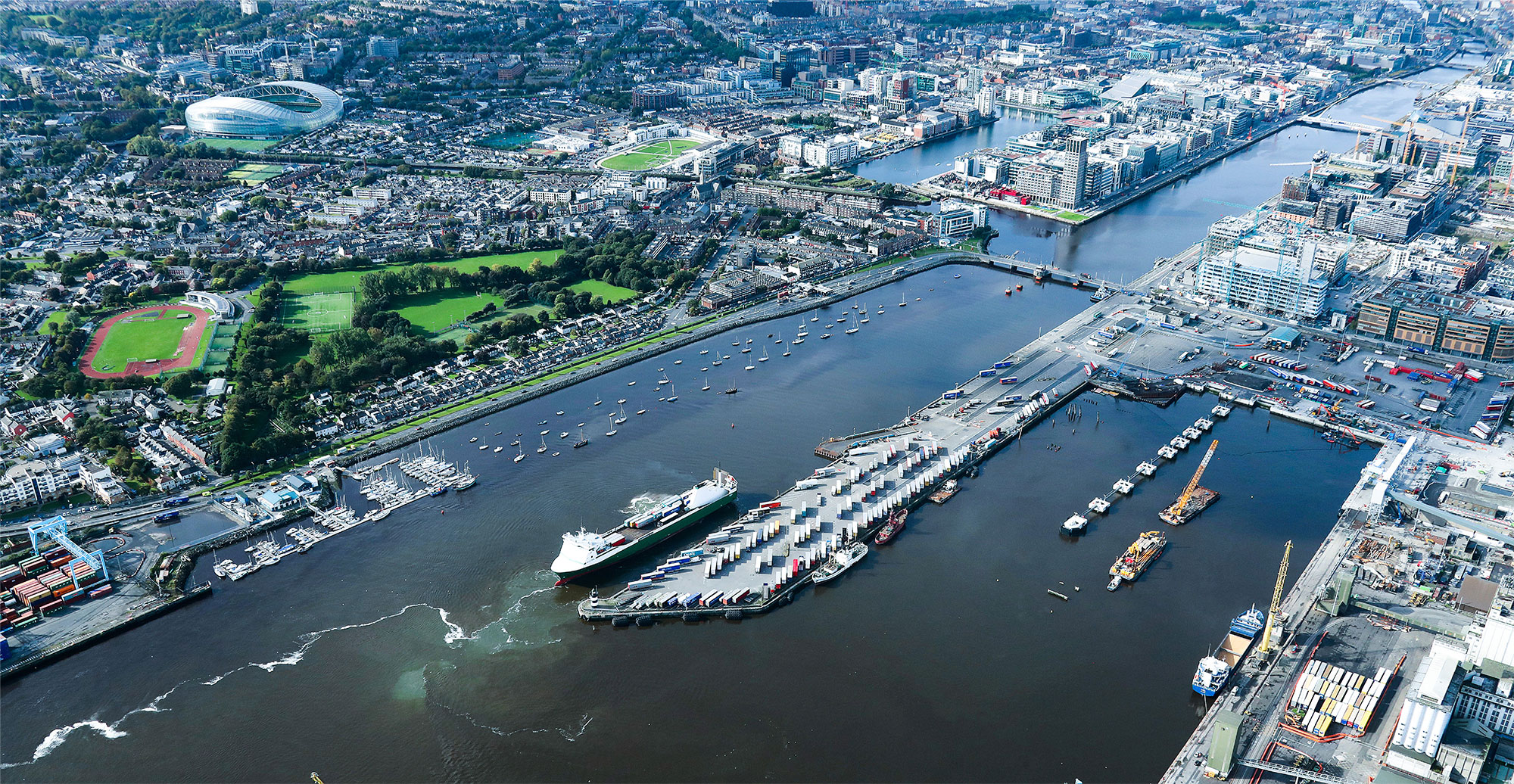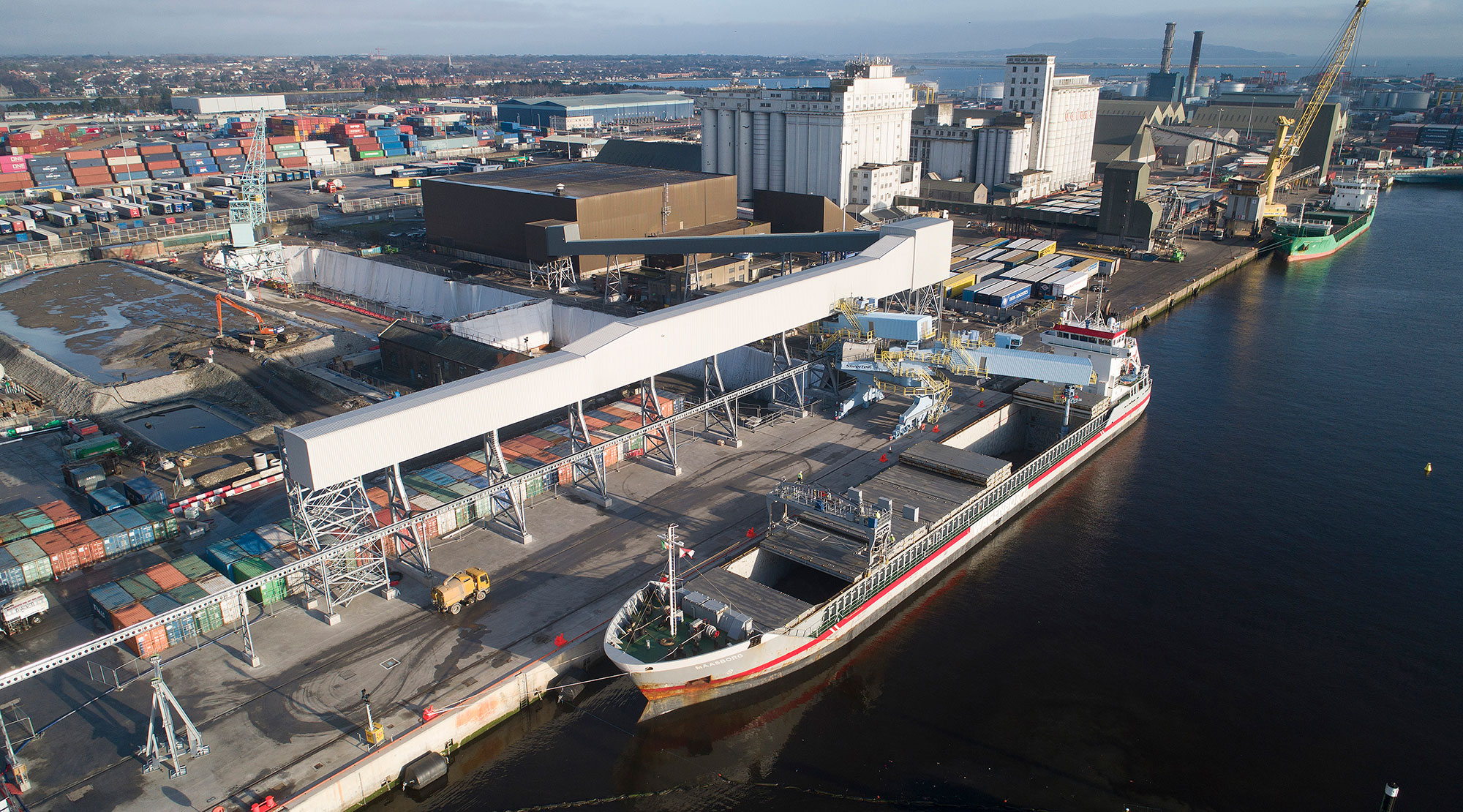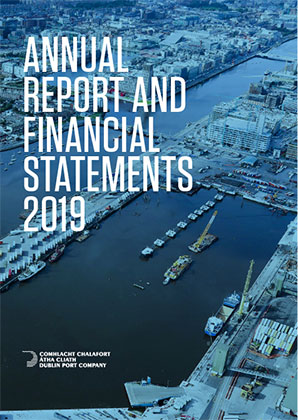Chief Executive’s Review


"OVERALL VOLUMES GREW BY A MODEST 0.4% TO 38.1M GROSS TONNES REPRESENTING THE FIFTH CONSECUTIVE YEAR OF RECORD LEVEL THROUGHPUT."

Dublin Port Trade Review
In 2019, and notwithstanding strong growth in the unitised trades, overall volumes grew by a modest 0.4% to 38.1m gross tonnes. This is the fifth consecutive year in which a record level of throughput has been achieved. Total volumes have grown by 36.1% over the last seven years and are now 23.3% higher than they were in 2007, prior to the economic downturn.
Imports grew more strongly than exports during 2019 at 0.5% and 0.1% respectively.
‘000 gross tonnes | 2019 | 2018 | % change |
|---|---|---|---|
Imports | 22,858 | 22,741 | 0.5% |
Exports | 15,280 | 15,253 | 0.1% |
Total | 38,138 | 37,994 | 0.4% |
Looked at by mode Ro-Ro grew in gross tonnes terms by +1.2% and Lo-Lo grew by +5.3%.
Growth in the two unitised modes combined was +2.1%.
By comparison, the non-unitised modes declined by -7.4%. Within this, Bulk Liquids grew by +0.9% and Bulk Solids declined by -23.4%.
‘000 gross tonnes | 2019 | 2018 | % change |
|---|---|---|---|
Ro-Ro | 24,348 | 24,050 | 1.2% |
Lo-Lo | 7,290 | 6,924 | 5.3% |
Bulk Liquid | 4,662 | 4,621 | 0.9% |
Bulk Solid | 1,820 | 2,375 | -23.4% |
Break Bulk | 17 | 24 | -27.9% |
Total | 38,138 | 37,994 | 0.4% |
Unitised | 31,638 | 30,974 | 2.1% |
Non-unitised | 6,499 | 7,020 | -7.4% |
The most significant change during the year was the decline of 0.6m tonnes in the Bulk Solid mode. This was driven largely by reductions in the import of animal feed and cereals and in the export of ore concentrates.
Gross tonnes imports/exports (‘000)
2019
38,138
2018
37,994
Imports
Exports
Gross tonnes modes (‘000)
2019
38,138
2018
37,994
Ro-Ro
Lo-Lo
Bulk Liquid
Bulk Solid
Break Bulk
Animal feed and cereal volumes in any given year are determined primarily by weather conditions in previous years’ growing seasons. When the supply of domestically produced grass and fodder is high, then the demand for animal feed and cereal imports is low.
The decline in ore concentrates was due to the temporary closure of Boliden Tara Mines export operation to facilitate construction works within the ABR Project. These works have now been completed and ore concentrate exports have returned to normal levels.
Trade vehicles were 4.4% lower in 2019 following growth of 4.1% the previous year.
2019 | 2018 | % | |
|---|---|---|---|
Trade vehicles | 98,897 | 103,443 | -4.4% |
A new multi-purpose ferry service commenced between Dublin and Cherbourg during the year contributing to strong growth of +6.7% in passenger numbers and +9.9% in tourist vehicles.
2019 | 2018 | % | |
|---|---|---|---|
Ferry passengers | 1,949,229 | 1,827,674 | 6.7% |
Tourist vehicles | 559,506 | 508,960 | 9.9% |
As with the tourism side of the ferry business, cruise tourism also performed strongly with 158 ships during 2019 compared to 150 the previous year.
In addition to having more cruise ships, the average size of ship increased by +11.1%.
2019 | 2018 | % | |
|---|---|---|---|
Cruise calls | 158 | 150 | 5.3% |
Passengers and crew | 323,234 | 276,927 | 16.7% |
GT | 8,792,405 | 7,512,749 | 17.0% |
Average GT per ship | 55,648 | 50,085 | 11.1% |
Looked at in terms of units for Ro-Ro and TEU for Lo-Lo, volumes grew by 2.6% and 6.5% respectively.
2019 | 2018 | % | |
|---|---|---|---|
Ro-Ro units | 1,059,103 | 1,031,897 | 2.6% |
Lo-Lo TEU | 774,000 | 726,928 | 6.5% |
Looking at long-term trends, Ro-Ro volumes are now 44.5% higher than they were in 2007. In addition, Lo-Lo volumes have finally grown to a higher level than they were 12 years ago.
2019 | 2007 | % change | |
|---|---|---|---|
Ro-Ro units | 1,059,103 | 733,141 | 44.5% |
Lo-Lo TEU | 774,000 | 743,937 | 4.0% |
Combining Ro-Ro and Lo-Lo (by measuring Lo-Lo in units rather than in TEU), total throughput for the year grew by +3.6% to 1.5m units.
Units | 2019 | 2018 | Change | % change |
|---|---|---|---|---|
Ro-Ro | 1,059,103 | 1,031,897 | 27,206 | 2.6% |
Lo-Lo | 432,510 | 407,463 | 25,047 | 6.1% |
Total | 1,491,613 | 1,439,360 | 52,253 | 3.6% |
Brexit effects
Although overall growth was modest at just +0.4%, there was significant growth in the unitised modes which drive the Company’s capital investment requirements.
62.5% of the total unitised volume of 1.5m units were on shipping services with the UK. The remaining 37.5% was on services with Continental Europe (CE) and beyond.
The most significant change during 2019 was that unitised trade with the UK declined by -0.2% while trade with Continental Europe and beyond increased by +10.7%.
2019 | 2018 | Change | % change | ||
|---|---|---|---|---|---|
UK | Ro-Ro | 897,479 | 889,557 | 7,922 | 0.9% |
Lo-Lo | 35,415 | 45,296 | -9,881 | -21.8% | |
Total UK | 932,894 | 934,853 | -1,959 | -0.2% | |
CE | Ro-Ro | 161,624 | 142,340 | 19,284 | 13.5% |
Lo-Lo | 397,095 | 362,167 | 34,928 | 9.6% | |
Total CE | 558,719 | 504,507 | 54,212 | 10.7% |
If this trend continues as Brexit progresses, then Dublin Port will need more capacity (berths and land) for a given volume of unitised freight in the future than would otherwise be required. This could be a challenge to achieving an ultimate capacity of 77m gross tonnes per annum by 2040 as envisaged in the Masterplan.

Financial Performance in 2019
Turnover for the year increased by €2.3m (2.6%) from €90.4m in 2018 to €92.7m in 2019. This is consistent with volume growth during the period and pricing adjustments applied during the year.
Total operating costs in 2019 amounted to €48.5m representing a €4.9m (11.2%) increase on the previous year due to a number of factors:
- Conclusion of a voluntary redundancy scheme at a cost of €2.9m and with a pay-back period of 2.1 years.
- Higher depreciation charge of €0.7m as a result of capital investment.
- Higher pension costs of €0.1m.
Excluding the foregoing items, day to day underlying operating costs increased by 3.7% from €32.7m in 2018 to €33.9m in 2019.
As a result of the above, the Company’s operating profit in 2019 was €44.2m representing a €3.2m (6.7%) reduction on the previous year when operating profit were €47.4m.
€’000 | 2019 | 2018 | % change |
|---|---|---|---|
Turnover | 92,723 | 90,374 | 2.6% |
Operating Profit | 44,229 | 47,388 | -6.7% |
PBT | 44,619 | 47,855 | -6.8% |
PAT | 38,645 | 41,521 | -6.9% |
The taxation charge for the year was €6.0m compared to €6.3m in 2018.
Profit for the Financial Year 2019 was €38.6m compared to €41.5m in 2018 representing a reduction of €2.9m (6.9%).
EBITDA (Earnings before Interest, Tax, Depreciation and Amortisation) decreased by €1.9m (3.3%) from €55.8m in 2018 to €54.0m in 2019. This reduction was largely driven by the €2.9m investment in the voluntary redundancy scheme as referred to above. Excluding this charge underlying EBITDA rose by €1.0m (1.8%) in 2019.
€’000 | 2019 | 2018 |
|---|---|---|
Operating Profit | 44,229 | 47,388 |
Depreciation | 10,318 | 9,599 |
Amortisation | (582) | (542) |
Other income | - | (600) |
Exceptional Items – profit on disposal of assets | (5) | (18) |
EBITDA | 53,960 | 55,827 |
Voluntary redundancy scheme | 2,883 | - |
Underlying EBITDA | 56,843 | 55,827 |
Return on Capital Employed (ROCE) for 2019 was 8.2% compared to 10.2% in 2018 reflecting the significant investment in fixed assets during the year. These totalled €564.5m compared to €496.6m at the end of 2018. The movement in Fixed Assets for the year is explained by additions of €78.1m offset by depreciation in the year of €10.2m.
The net debt position at year end is summarised as follows.
€m | 2019 | 2018 |
|---|---|---|
Borrowings | 198.6 | 134.8 |
Cash | 77.3 | 43.3 |
Net Debt | 121.3 | 91.6 |
Total borrowings increased by €63.8m following drawdown of the first tranche of €100m from a new €300m private placement debt facility entered into with Allianz. Repayments of Ulster Bank and EIB loans during the year amounted to €36.3m.
As a result of the additional financing now in place the Company is well placed to continue implementing the
Masterplan’s capital investment programme with investment in infrastructure of over €1 billion planned over the next ten years.
Outlook for 2020
Following consistent growth since 2013, 2019 was a challenging year because of Brexit.
In preparation for this we have provided facilities on ten hectares of port lands for State agencies including Customs and the Department of Agriculture, Food and the Marine. This is a significant loss of scarce lands which we had never envisaged when first developing the Masterplan in 2012. Brexit preparations have also been disruptive of on-going capital projects and at the end of 2020 we face the uncertainty of delays as a result of the introduction of new checks on trade with Great Britain.
Having provided infrastructure for border inspection services required because of Brexit, we will depend on third parties (State agencies, ferry companies and their haulier customers) to complete preparations during 2020 to ensure the continued smooth flow of trade with GB.
During 2020, we anticipate a decision from An Bord Pleanála on our MP2 Project planning application. This is the second of three strategic infrastructure development (SID) projects which, between them, will deliver the vision of Masterplan 2040 and we will, during 2020, commence work on the third and final SID project to develop facilities on the Poolbeg Peninsula. This will include the construction of a Southern Port Access Route as an internal port road to provide access to and from the Dublin Port Tunnel for port traffic from the south side of the port.
Planning future port capacity which can take up to 20 years to deliver is challenging and we will also need, during 2020, to begin to think about where and how additional port capacity will be provided on the east coast of the country to cater for growth post 2040 by which stage we believe that Dublin Port will have reached its ultimate throughput capacity.
Dublin Port Company is self-financing and must develop the port from within its own resources. Taking on large debt requires us to generate a commensurate level of profits. We had intended during 2019 to review our port infrastructure charges and implement a pricing policy to enable the Company to continue to deliver the Masterplan’s capital investment programme over the next decade and beyond. This was deferred and will now take place during 2020.
The coming year will also see major initiatives in Health & Safety not only with the Company’s operations but throughout all operations in Dublin Port both on land and on the water.
In addition, we will recruit environmental and ecology specialists to introduce new skillsets into the Company essential if we are to address the variety of environmental challenges including climate change, air quality and biodiversity.
Having completed a public consultation on cruise, we will during 2020 take important decisions as to whether we proceed with the development of North Wall Quay Extension to provide berths for large cruise ships.
Finally, Covid-19 has in a very short space of time had a significant impact on the economic activity of the country. While this will inevitably have a negative impact on our throughput volumes and consequently on our revenues, Dublin Port remains a key part of national infrastructure and a key node within the transport chain to ensure the continued flow of essential imports and exports. We will continue to review all expenditure, both operating and capital to ensure that the Company retains the liquidity and financial strength to maintain its ability to deliver on its core mandate of facilitating trade.
Eamonn O’Reilly
Chief Executive
27th March 2020

